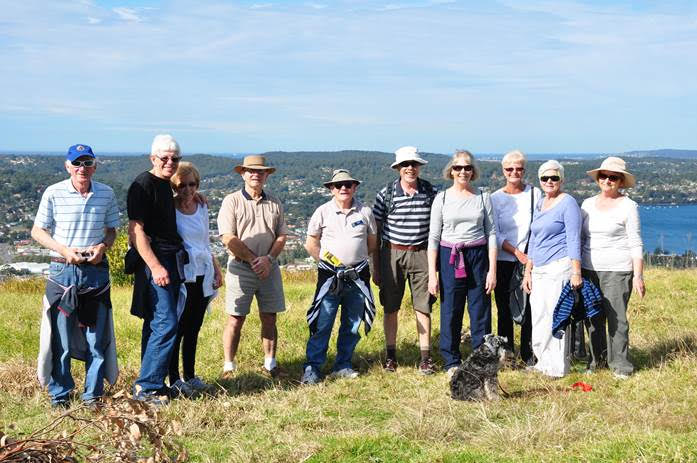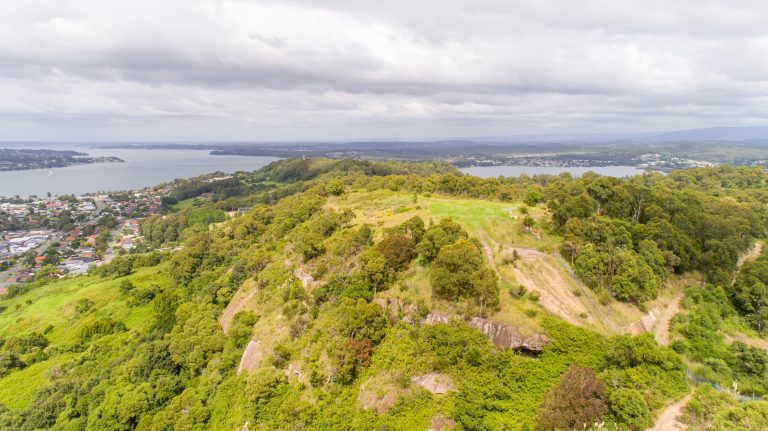Artist reflects on times spent exploring Munibung Hill
Back in the mid 70s and early 80s Munibung Hill was a children’s paradise. In part two, Luke Adams, now an artist living in Melbourne, shares the story of his virtual neighbour – growing up next door to Munibung Hill.
Luke said: Another significant event was held in 1988.The Bicentennial Beacons consisted of a series of bonfires lit around the coast of Australia. Luke and his family attended the event at Munibung Hill, (see two notations below), at what is now the high point at the northern end near where the telecommunication towers are situated today.
“The lighting of a beacon at Horseshoe Beach, Newcastle triggered the next beacon at Charlestown, then Munibung Hill beacon was lit, which was a signal towards the south. The lighting of beacons one-after-another progressed down the East Coast of Australia.”
“Looking back on our access to Munibung Hill it is a conflicting relationship. We always had an awareness that an indigenous presence would have been at Munibung Hill and that old walking trails would have existed. There was a cave that not many people knew about on the northside of the Quarry Road ridge. It was hard to access. But unfortunately, it caved-in around 1990. I imagined this may have been used prior to colonial settlement” *
“As kids, we used to go to the ‘Cats-eye-caves’ all the time. You can see them from Hawkins Road.” Luke thinks they got their name because of the shape of the opening of the small caves. The track to this area is now overgrown, making the area inaccessible, which is probably a good thing, until the Management Plan is adopted.
In Luke’s grandparent’s day his grandmother walked across Munibung Hill to visit family and friends on the other side. That would have been around the 40s and 50s before car transport became common.
The complexity of issues facing us across Australia could be likened to the issues being played out at Munibung Hill.
“When it comes to animal life at Munibung Hill, there were lots of foxes, cats and rabbits,” said Luke. “Even back in those days.” (Editor: With the additional housing development we have no idea of the number of roaming domestic cats visiting and predating on wildlife at Munibung Hill, but we know it must be hundreds).
Back in the days when Luke was growing up, “there were plenty of owls, tawny frogmouths, echidna, possums, heaps of blue tongue lizards, frogs everywhere and green tree snakes.”
An abundance of flying foxes had camps at Munibung Hill, but it’s only been in recent times that Luke has learnt there are threatened microbats living at the hill.
Luke shares our concern that Munibung Hill has become cut off from surrounding bushland.
“All the Glendale shopping area, back in those days was bush that linked up with Munibung Hill, except for the train line and railway fences. All that bush was removed for commercial development”
But there are some good things to note.
“The top ridge line that was impacted by cattle grazing is regenerating, the quarries have shut down, the lead smelter is gone, and there are no more trail bike tracks. These were all competing demands on the natural environment 30 and 40 years ago, back in the 80s.”
A lot of what Luke terms self-serving behaviour has been replaced with something akin to a conservation ethic of today.
“This means there are now opportunities that we would not have had before. This needs to be kept in mind, because as we now recognise, Munibung Hill is a very diverse landscape with some parts that are relatively untouched. When we expand our worldview, we find that the micro issues being played out at Munibung Hill, the tension between conserving forest and expanding suburbia, protecting wildlife habitat from encroaching human introduced species such as cats, places huge pressures on nature. How we address these tensions will determine how viable the remaining landscape will be for other species we share our suburbs with,” said Luke.
“My artistic work attempts to make sense of our ability to adapt our varied cultural traditions within a global sensibility, while addressing our impact on the natural world.’
Much of Luke’s family still live in the area. His Mum, Dad and sister all live within 10 km’s of where he grew up and the broader family mostly live in Lake Macquarie and Newcastle. So, there are good reasons to visit every year.
Luke was the inaugural artist-in-residence for the Lake House Artist Residency with the City of Lake Macquarie. He spent two weeks in his old stomping ground of Speers Point in December-January 2022 and exhibited his painting studies at the Museum of Art and Culture (MAC Gallery) at the end of January. He is developing a larger body of artwork that reflects on life growing up around the lake. His latest project is a collection of works that will include painting, video, performance and sculpture. It’s highly likely that Munibung Hill will feature somewhere in the mix.
In relation to the bicentennial beacons mentioned by Luke, these two references from the historical records add a small amount of detail …
2000 watch as beacon blazes
Newcastle Herald, June 20, 1988
More than 2000 people braved chilling winds at Horseshoe Beach to watch the flames of Newcastle’s Bicentennial ‘Birthday Beacon’ lick more than 25 metres into the air.
The fire was one of the last of about 500 lit around Australia in the Bicentenary’s truly national event.
The Governor General Sir Ninian Stephen, set off the chain on Saturday night by lighting a 50 tonne bonfire at Botany Bay, in Sydney.
From there the chain of beacon lighting continued south along the coast, looping around Australia and arriving back in the Hunter at Stoud, then Nelson Bay and Newcastle.
Thousands more witnessed the lighting of other local beacons at Munibung Hill and Morpeth.
Lake Macquarie City Council
At the Meeting of Council held at Speers Point, Monday, 20th June, 1988.
Ald . Edwards and Ald. Carley, moved:
.. That Council recognises the two very successful Bicentenary Events held on the weekend of the 18th and 19th of June, 1988, namely the Mayoral Ball and the lighting of the Beacon on Munibung Hill; and further,
.. That Council also recognise the work carried out by its staff on Friday, 17th June, 1988 under adverse conditions in respect of the preparations for the Munibung Hill Event ; and further,
.. That the Wyee Bush Fire Brigade be thanked for their involvement in building the Beacon on Munibung Hill and undertaking the feeding of those persons present at that event.
MMM … Issue 34, October-November 2022



